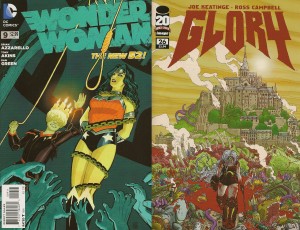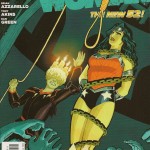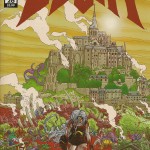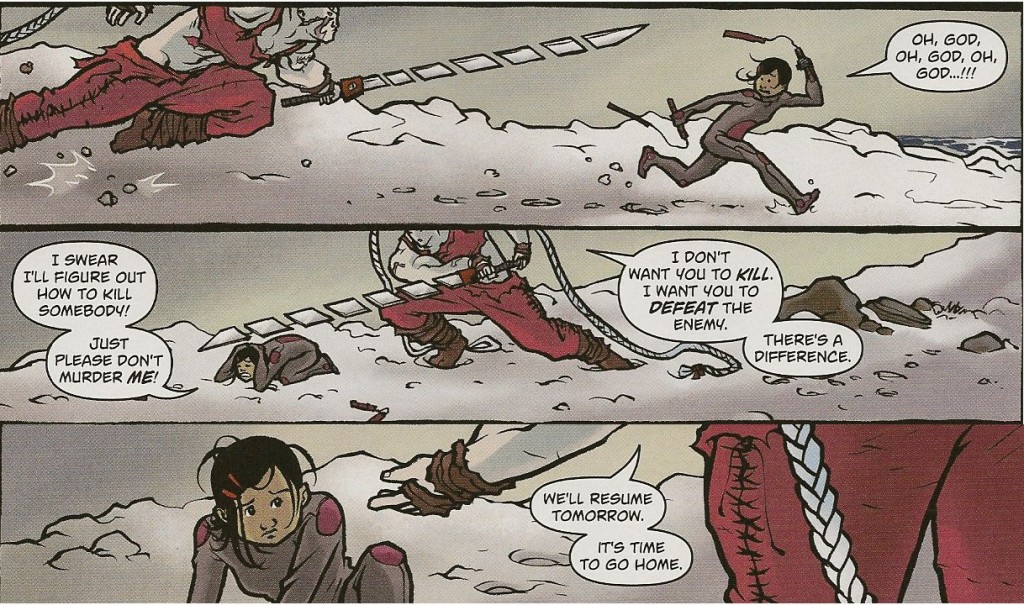 Once upon a time, in 1941, the character of Wonder Woman was created by a Harvard educated psychologist (and apparent bondage enthusiast) named William Moulton Marston. Wonder Woman is/was an Amazon princess, sent to the world of man as an ambassador of peace. Marston created Wonder Woman to be the embodiment of a type of liberated woman who was atypical in that period of history. Indeed Marston wrote, “Wonder Woman is psychological propaganda for the new type of woman who should, I believe, rule the world.” (Wow. Auspicious.) However, “psychological propaganda” origins aside, the character has been popular with men and women for decades. In fact, in 2011, IGN named Wonder Woman fifth from the top on a list of the Top 100 Comic Book Characters Of All Time.
Once upon a time, in 1941, the character of Wonder Woman was created by a Harvard educated psychologist (and apparent bondage enthusiast) named William Moulton Marston. Wonder Woman is/was an Amazon princess, sent to the world of man as an ambassador of peace. Marston created Wonder Woman to be the embodiment of a type of liberated woman who was atypical in that period of history. Indeed Marston wrote, “Wonder Woman is psychological propaganda for the new type of woman who should, I believe, rule the world.” (Wow. Auspicious.) However, “psychological propaganda” origins aside, the character has been popular with men and women for decades. In fact, in 2011, IGN named Wonder Woman fifth from the top on a list of the Top 100 Comic Book Characters Of All Time.
Meanwhile, in 1993, the character of Glory was created by comic book illustrator (and foot extraction hobbyist) Rob Liefeld. Glory was created for Liefeld’s Extreme Studios at Image Comics. Glory is a half Amazonian/half demon offspring, who leaves the Amazonians to enter the world of man and kick a lot of ass. Liefeld created Glory to have a Wonder Woman type character to run around in his Extreme universe and give him an excuse to draw cheesecake.
Since DC’s reboot this past fall has served to drag 90s comic book culture back kicking screaming to the profitable fore, it is not surprising that Image has decided to relaunch some of Liefeld’s past creations, such as Supreme, Youngblood, and Glory. What might be surprising is that Glory is a better Wonder Woman comic than the one being written currently at DC by Brian Azzarello.
Why?
Read on for spoiler laden comparisons, Scooby Gangs, and basement dwelling emo gods.
 There is no denying that Brian Azzarello’s Wonder Woman has been one of the breakout successes of the DC reboot. Wonder Woman is now a top 20 title, after a prolonged period of slumping sales despite having gone through previous creative rosters that have included other talented writers, such as Jodi Picoult, Greg Rucka, and Gail Simone. In order to get readers’ attentions, Azzarello has shaken up Wonder Woman’s world by ripping away everything that she (and her fans) thought to be true about her origins and the world around her. No longer a clay vessel brought to life out of the desire her mother, Hippolyta, to have a child in the female only world of Themyscira, Wonder Woman discovers that she is the illicit love child of an affair between her mother and Zeus, the king of the gods. As if this wasn’t enough, despite the fact that Wonder Woman’s duty has been as an ambassador of peace to the world of men, her fellow Amazons have been going out every few years to rape men for the purposes of procreation. Oh, and any boy children produced as a by-product get traded off to Hephaestus to work in his forge as part of an arms deal.
There is no denying that Brian Azzarello’s Wonder Woman has been one of the breakout successes of the DC reboot. Wonder Woman is now a top 20 title, after a prolonged period of slumping sales despite having gone through previous creative rosters that have included other talented writers, such as Jodi Picoult, Greg Rucka, and Gail Simone. In order to get readers’ attentions, Azzarello has shaken up Wonder Woman’s world by ripping away everything that she (and her fans) thought to be true about her origins and the world around her. No longer a clay vessel brought to life out of the desire her mother, Hippolyta, to have a child in the female only world of Themyscira, Wonder Woman discovers that she is the illicit love child of an affair between her mother and Zeus, the king of the gods. As if this wasn’t enough, despite the fact that Wonder Woman’s duty has been as an ambassador of peace to the world of men, her fellow Amazons have been going out every few years to rape men for the purposes of procreation. Oh, and any boy children produced as a by-product get traded off to Hephaestus to work in his forge as part of an arms deal.
Issue #9 finds us with an incredibly passive Wonder Woman. In issue #8 she has allowed herself to get shot, by Hades, with Eros’s pistol of love (yes, you read that right and it’s not a euphemism…mostly) in order to free a mortal woman, who is the most recent baby mama of a missing Zeus, from Hades’s realm. Wonder Woman is now apparently in love with Hades and about to get married off to him. But Hades is a petulant man-child (literally…he is a wee lad) who not only sits in his grandmother’s basement (if you consider that Gaia, the Earth, is his grandma and that the bowels thereof are her basement) and bitches that not enough family are coming to the wedding, but frets that Wondy doesn’t really love him, even though he shot her with the god of love’s own damn weapon mere hours ago. Instead of giving Hades the bitch slapping he so clearly deserves, Wonder Woman allows Hades to take her to a noose fashioned by her own lasso so that she will be compelled to tell the truth about her love or hang for her dishonesty. No wonder Hades is so frustrated all the time; he obviously doesn’t understand the first thing how to choke his…
Anyway.
When do we see some full on ass kicking by Wonder Woman in this series? Azzarello has primarily used the storyline so far to tell a Greek gods walk among us tale with nods to The Sopranos, Sandman, and Good Omens. He has spent more time developing the gang of characters around her, or even just throwing in new ones, than he has his title character. Wonder Woman‘s story currently feels driven by a conflict that arises out of circumstance (the new origin) and the author’s need to world build, than by a story of a character with recognizable needs she needs to fill. What does she want, Azzarello? She saved Zola, the pregnant girl. What truth is going to come spilling out of her mouth when that noose gets slipped around her neck? “I don’t love you Hades. Also, the truth is I want my continuity to go back to the way it was.” Eh, probably not.
 Glory feels like a cleaner reboot, if only because there was less backstory and baggage attached to her to begin with. Oh, and there is action and ass kicking. That’s all I ask out of my super heroes, really. Kick some ass, preferably at least once per issue.
Glory feels like a cleaner reboot, if only because there was less backstory and baggage attached to her to begin with. Oh, and there is action and ass kicking. That’s all I ask out of my super heroes, really. Kick some ass, preferably at least once per issue.
Writer Joe Keatinge, in the space of 4 issues, has brought readers up to speed on Glory’s origins (which remain fairly true to Liefeld’s concept), assembled her a Scooby Gang – comprised by some strong female characters, given us a glimpse into a dark future for the supposedly heroic title character, and brought the planet to the brink of war. Whew! Oh, and she told the Superman analog, Supreme, more or less to fuck off in a previous issue.
This is a flat out fun story. If Wonder Woman creator Marston was looking to create an empowered character that in turn empowers other women, this is that character. With her father’s demon army ready to invade the planet Earth, Glory knows what going into war will do to her. Every time she gives in to her savage bloodlust, the possibility that she will not be able to pull herself back from the demonic brink becomes an increasingly larger possibility. This is the future that has been hinted at to her young protege, Riley. So it falls to Glory to train Riley, not just for Riley’s own protection, but for the safety of mankind as well.

Consider that particularly in contrast with Azzarello’s Wonder Woman running around trying to save a damsel in distress, rather than finding a way to teach her to save herself.
Furthermore, Ross Campbell’s artwork is striking and brings a unique look to the characters. Unlike Liefeld’s impossibly Barbie looking original concept, Glory is drawn by Campbell the way you might actually expect a character that is half “Amazonian” to look – freaking huge, battle scarred, and menacing. There’s a reason Supreme flies off after his confrontation with her rather than throwing down. However, Glory’s facial characteristics (as well as some of the other characters) have an oddly childlike quality to them. It works though, superimposing a level of innocence on Glory’s expressions that belie the demon hiding beneath. That the artwork is the biggest change in Glory’s reboot, and yet works so well in it, is just one more contrast to the new reboot of Wonder Woman: Tony Atkins’s art in Wonder Woman. His visual characterization of Wonder Woman is old school and makes her look exactly as any fan young or old might expect. The comforting lack of surprise in the art is one of the few good things about Wonder Woman.
Bottom line – The best Wonder Woman story out there right now is Glory.
 Podcast RSS Feed
Podcast RSS Feed iTunes
iTunes Google Play
Google Play Stitcher
Stitcher TuneIn Radio
TuneIn Radio Android
Android Miro Media Player
Miro Media Player Comics Podcast Network
Comics Podcast Network